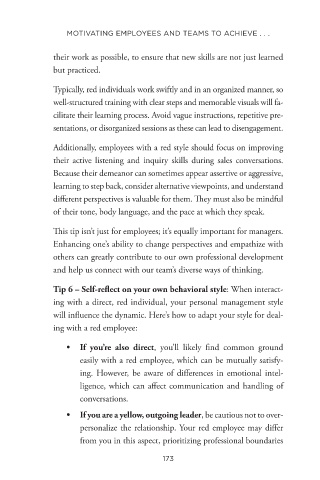Page 175 - Boettcher.indb
P. 175
MOTIVATING EMPLOYEES AND TEAMS TO ACHIEVE . . .
their work as possible, to ensure that new skills are not just learned
but practiced.
Typically, red individuals work swiftly and in an organized manner, so
well-structured training with clear steps and memorable visuals will fa-
cilitate their learning process. Avoid vague instructions, repetitive pre-
sentations, or disorganized sessions as these can lead to disengagement.
Additionally, employees with a red style should focus on improving
their active listening and inquiry skills during sales conversations.
Because their demeanor can sometimes appear assertive or aggressive,
learning to step back, consider alternative viewpoints, and understand
different perspectives is valuable for them. They must also be mindful
of their tone, body language, and the pace at which they speak.
This tip isn’t just for employees; it’s equally important for managers.
Enhancing one’s ability to change perspectives and empathize with
others can greatly contribute to our own professional development
and help us connect with our team’s diverse ways of thinking.
Tip 6 – Self-reflect on your own behavioral style: When interact-
ing with a direct, red individual, your personal management style
will influence the dynamic. Here’s how to adapt your style for deal-
ing with a red employee:
• If you’re also direct, you’ll likely find common ground
easily with a red employee, which can be mutually satisfy-
ing. However, be aware of differences in emotional intel-
ligence, which can affect communication and handling of
conversations.
• If you are a yellow, outgoing leader, be cautious not to over-
personalize the relationship. Your red employee may differ
from you in this aspect, prioritizing professional boundaries
173

